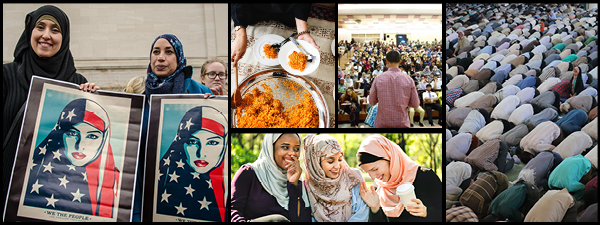

Islam is the world’s second-largest religion after Christianity, with an estimated 1.8 billion Muslims worldwide. It is the third-largest religion in the United States after Christianity and Judaism with an estimated 3.3 million adherents, about 1 percent of the population. American Muslims are one of the most racially diverse groups with no majority race or ethnicity. Given this diversity and the range of geopolitical and sociopolitical circumstances, there can be challenges when covering Islam and Muslims that do not exist for some other belief systems.
Muslim ethnic and racial identity is split between those who identify as Arab, Asian, Caucasian and black. It includes Latinos, Native Americans and those who identify as mixed race. About half of Muslims in the U.S. are native-born, and more than 85% are American citizens. Muslims have been in America since before the nation’s founding with an estimated one quarter to one third of Africans brought to the United States during the trans-Atlantic slave trade being Muslim. This diversity can be challenging for journalists as second generation Arab Muslims may have very different life experiences than Muslims of African descent whose families have been in the U.S. for many years.
Institutions and religious spaces can greatly differ in makeup among Muslim communities, making it difficult to identify a single place to get information on religious practices and beliefs. A compounding factor for covering Muslim communities is the diversity in belief and lack of hierarchy. There is no overarching body that represents the faith. In addition, there are various sects of Islam, even beyond the well-known branches of Shia and Sunni. Journalists should be very careful about attending one mosque or religious space and assuming it is representative of Muslim communities at-large or of Islam as a whole.
Many myths exist about Muslim communities, requiring journalists to be careful to report facts and verify information about beliefs and practices. A visit to one mosque or community center cannot provide a view of every segment of Muslim life. Restaurants, shops, schools, and Facebook groups, etc. can be much better places to find the “average” Muslim.
Be cautious about overrepresenting Muslims in stories related to immigration or national security and not covering crimes against Muslims with the same persistence as crimes committed by Muslims. Exercise caution in using terms that might be considered pejoratives, including such phrases as “religious garb” and “tradition Islamic/Muslim clothing.” Clothing is unique to cultures, not religion. Routinely showing Muslim calls to prayer and people praying can present a stereotype of Muslims and reduce the faith to one dimension.
Verify that an individual is qualified to be identified as an “expert.”
Having reporters reach out and go beyond what can be found in printed and online resources is important. These can be complicated issues, so in-person contact is invaluable.
The Institute for Social Policy and Understanding (ISPU) is a non-partisan, secular research organization that offers publications that are helpful in understanding the American Muslim community. These include:
There are a number of journalists working to improve coverage of Muslims:
The Institute for Social Policy and Understanding has a network of scholars on a variety of different topics that are available to media. They are listed on the organization’s website and can be contacted either directly or through ISPU. Another source of experts is http://www.eightpointfivemillion.org.
Other organizations that provide background information on the Muslim community and Islam include:
